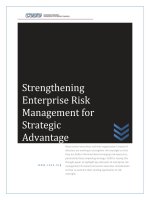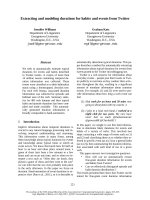Risk management for meetings and events
Bạn đang xem bản rút gọn của tài liệu. Xem và tải ngay bản đầy đủ của tài liệu tại đây (3.52 MB, 381 trang )
Risk Management for Meetings and Events
Books in the series
Management of Events Operations
Julia Tum, Philippa Norton and J. Nevan Wright
Innovative Marketing Communications: Strategies for the Events Industry
Guy Masterman and Emma H. Wood
Events Management (second edition)
Glenn A. J. Bowdin, Johnny Allen, William O’Toole, Rob Harris and Ian McDonnell
Events Design and Experience
Graham Berridge
Marketing and Selling Destinations and Venues: A Convention and
Events Perspective
Tony Rogers and Rob Davidson
Human Resource Management for Events
Lynn Van der Wagen
Event Studies
Don Getz
Risk Management for Meetings and Events
Julia Rutherford Silvers
Risk Management for
Meetings and Events
Julia Rutherford Silvers, CSEP
• BOSTON • HEIDELBERG • LONDON • NEW YORK • OXFORD
PARIS • SAN DIEGO • SAN FRANCISCO • SINGAPORE • SYDNEY • TOKYO
AMSTERDAM
Butterworth-Heinemann is an imprint of Elsevier
Butterworth-Heinemann is an imprint of Elsevier
Linacre House, Jordan Hill, Oxford OX2 8DP, UK
30 Corporate Drive, Suite 400, Burlington, MA 01803, USA
First edition 2008
Copyright © 2008, Julia Rutherford Silvers. Published by Elsevier Ltd. All rights reserved
The right of Julia Rutherford Silvers to be identified as the author of this work has
been asserted in accordance with the Copyright, Designs and Patents Act 1988
No part of this publication may be reproduced, stored in a retrieval system or
transmitted in any form or by any means electronic, mechanical, photocopying,
recording or otherwise without the prior written permission of the publisher
Permissions may be sought directly from Elsevier’s Science & Technology Rights
Department in Oxford, UK: phone (ϩ44) (0) 1865 843830; fax (ϩ44) (0) 1865 853333;
email: Alternatively you can submit your request online by
visiting the Elsevier web site at and selecting
Obtaining permission to use Elsevier material
Notice
No responsibility is assumed by the publisher for any injury and/or damage to
persons or property as a matter of products liability, negligence or otherwise, or
from any use or operation of any methods, products, instructions or ideas contained
in the material herein. Because of rapid advances in the medical sciences, in
particular, independent verification of diagnoses and drug dosages should be made
British Library Cataloguing in Publication Data
A catalogue record for this book is available from the British Library
Library of Congress Cataloging-in-Publication Data
A catalog record for this book is available from the Library of Congress
ISBN: 978-0-7506-8057-8
For information on all Butterworth-Heinemann publications
visit our web site at
Typeset by Charon Tec Ltd (A Macmillan Company), Chennai, India
Printed and bound in Great Britain
08
09
10
10
9
8
7
6
5
4
3
2
1
This book is dedicated to my husband Larry, who shares
my optimistic pessimism and penchant
for planning for everything that could go wrong.
This page intentionally left blank
Contents
The author
Series editors
Series preface
Preface
Acknowledgments
List of figures
List of tables
Part One: Understanding risk management
xi
xiii
xv
xvii
xxi
xxiii
xxv
1
1 The role of risk management for meetings and events
Introduction
Risk, management, and risk management
The role and scope of events
The role and scope of event management
The integration of risk management and event management
Summary
Chapter review challenge
Practical risk management exercise
Key terminology
Online resources
3
3
4
7
11
17
20
21
21
22
22
2 The risk management process, tools, and techniques
Introduction
The risk management process
The tools and techniques for effective risk management
Summary
Chapter review challenge
Practical risk management exercise
Key terminology
Online resources
24
24
25
35
47
48
48
50
52
Part Two: The scope of risk management
53
3 Legal and ethical compliance
Introduction
Legal responsibility
Contracts and other legal documents
Statutory and regulatory obligations
Compliance management
Ethical issues
Summary
55
55
56
59
62
70
72
76
viii Contents
Chapter review challenge
Practical risk management exercise
Key terminology
Online resources
77
77
77
79
4 Health and safety
Introduction
Life safety codes
Public health issues
Occupational health and safety
Summary
Chapter review challenge
Practical risk management exercise
Key terminology
Online resources
80
80
81
89
93
99
100
100
101
101
5 Loss prevention and security
Introduction
Loss prevention
Contingency and continuity planning
Risk financing and insurance
Security
Summary
Chapter review challenge
Practical risk management exercise
Key terminology
Online resources
103
103
103
106
108
112
123
124
124
125
125
6 Emergency preparedness
Introduction
Emergency management
Mitigation
Preparedness
Response
Recovery
Evacuations
Medical emergencies
Summary
Chapter review challenge
Practical risk management exercise
Key terminology
Online resources
127
127
128
129
134
138
140
142
146
149
150
151
151
152
Part Three: Organizational safeguards
155
7 Administrative safeguards
Introduction
Time management
157
157
158
Contents ix
Financial management
Human resources management
Procurement management
Systems management
Summary
Chapter review challenge
Practical risk management exercise
Key terminology
Online resources
162
167
173
178
180
181
181
181
183
8 Communications
Introduction
Communications management
Information management
Stakeholder management
Summary
Chapter review challenge
Practical risk management exercise
Key terminology
Online resources
184
184
188
199
204
208
209
210
210
211
9 Marketing issues
Introduction
Marketing plan
Promotions
Public relations
Sponsorship management
Sales activities
Summary
Chapter review challenge
Practical risk management exercise
Key terminology
Online resources
212
212
213
218
222
227
230
232
233
233
233
235
Part Four: Operational safeguards
237
10 Program design
Introduction
Designing the experience
Designing the environment
Food and beverage service
Entertainment
Production elements
Summary
Chapter review challenge
Practical risk management exercise
Key terminology
Online resources
239
239
241
246
250
254
257
260
261
262
262
263
x Contents
11 Site management
Introduction
Site selection
Site planning and development
Infrastructure management
Managing the logistics
Summary
Chapter review challenge
Practical risk management exercise
Key terminology
Online resources
264
264
264
270
272
280
283
284
284
286
287
12 Attendee management
Introduction
Attendee and participant management
Crowd management and control
Attendee care and comfort
Summary
Chapter review challenge
Practical risk management exercise
Key terminology
Online resources
288
288
289
295
304
306
307
308
308
309
Appendix A: Event concept worksheet
Appendix B: Risk register worksheet
Appendix C: Site inspection checklist
Appendix D: Security plan worksheet
Appendix E: Sample instructions for security personnel
Appendix F: Emergency plan worksheet
Appendix G: Disaster preparedness supply kits
Appendix H: Sample change order form
Appendix I: Radio protocol
Appendix J: Sample contact list
Appendix K: Sample incident report form
Appendix L: Stakeholder analysis worksheet
Appendix M: Site plan worksheet
References
311
312
313
316
318
320
325
329
330
332
333
335
336
337
Index
347
The author
Julia Rutherford Silvers, a Certified Special Events Professional, is an adjunct faculty member of the
Tourism and Convention Department at the University of Nevada, Las Vegas, for whom she teaches
Meetings and Event Risk Management and Meetings and Event Coordination online. She designed
and wrote the Event Management Training Program for South Africa’s Tourism Learnership Project
National Certificate in Tourism: Event Support, the CSEP Study Course Workbook for the International
Special Events Society, as well as numerous distance learning courses, instructional videos, CD ROM
lectures, books, magazine articles, and award-winning research papers on event management topics.
She is the originator of The Event Management Body of Knowledge (EMBOK) Project, an educational
resource on her Web site that illustrates and examines the scope of knowledge and processes used in
the events industry. She is a Charter Member of the International EMBOK Executive, serves on the
Editorial Advisory Board for the World Journal of Managing Events for the World Research
Organization, and is a four-time International Special Events Society Esprit Award winner for Best
Industry Contribution for her event management educational programs.
This page intentionally left blank
Series editors
Glenn A. J. Bowdin is Principal Lecturer in Events Planning at the U.K. Centre for Events
Management, Leeds Metropolitan University where he has responsibility for managing eventsrelated research. He is co-author of Events Management. His research interests include the area of service quality management, specifically focusing on the area of quality costing, and issues relating to the
planning, management, and evaluation of events. He is a member of the Editorial Boards for Event
Management (an international journal) and Journal of Convention & Event Tourism, Chair of AEME
(Association for Events management Education), Charter Member of the International EMBOK
(Event Management Body of Knowledge). Executive and a member of Meeting Professionals
International (MPI).
Don Getz is a Professor in the Tourism and Hospitality Management Program, Haskayne School of
Business, the University of Calgary. His ongoing research involves event-related issues (e.g., management, event tourism, events and culture) and special-interest tourism (e.g., wine). Recent books
include Event Management and Event Tourism and Explore Wine Tourism: Management, Development,
Destinations. He co-founded and is a member of the Editorial Board for Event Management (an international journal).
Professor Conrad Lashley is Professor in Leisure Retailing and Director of the Centre for Leisure
Retailing at Nottingham Business School, Nottingham Trent University. He is also series editor for the
Elsevier Butterworth-Heinemann series on Hospitality Leisure and Tourism. His research interests
have largely been concerned with service quality management, and specifically employee empowerment in service delivery. He also has research interest and publications relating to hospitality management education. Recent books include Organisation Behaviour for Leisure Services, 12 Steps to Study
Success, Hospitality Retail Management, and Empowerment: HR Strategies for Service Excellence. He has coedited, Franchising Hospitality Services and In Search of Hospitality: Theoretical perspectives and debates. He
is the past Chair of the Council for Hospitality Management Education. He is a Chair of the British
Institute of Innkeeping’s panel judges for the NITA Training awards, and is advisor to England’s East
Midlands Tourism network.
This page intentionally left blank
Series preface
The events industry, including festivals, meetings, conferences, exhibitions, incentives, sports and a
range of other events, is rapidly developing and makes a significant contribution to business and
leisure related tourism. With increased regulation and the growth of government and corporate
involvement in events, the environment has become much more complex. Event managers are now
required to identify and service a wide range of stakeholders and to balance their needs and objectives. Though mainly operating at national levels, there has been significant growth of academic
provision to meet the needs of events and related industries and the organizations that comprise
them. The English speaking nations, together with key Northern European countries, have developed programs of study leading to the award of diploma, undergraduate and post-graduate
awards. These courses focus on providing education and training for future event professionals,
and cover areas such as event planning and management, marketing, finance, human resource
management and operations. Modules in events management are also included in many tourism,
leisure, recreation and hospitality qualifications in universities and colleges.
The rapid growth of such courses has meant that there is a vast gap in the available literature on
this topic for lecturers, students, and professionals alike. To this end, the Elsevier ButterworthHeinemann Events Management Series has been created to meet these needs to create a planned
and targeted set of publication in this area.
Aimed at academic and management development in events management and related studies, the
Events Management Series:
●
●
●
●
●
●
provides a portfolio of titles which match management development needs through various
stages;
prioritizes publication of texts where there are current gaps in the market, or where current provision is unsatisfactory;
develops a portfolio of both practical and stimulating texts;
provides a basis for theoretical and research underpinning for programs of study;
is recognized as being of consistent high quality;
will quickly become the series of first choice for both authors and users.
This page intentionally left blank
Preface
Hope is NOT an Action Plan
In August 2005 a two-day risk management workshop was held in Johannesburg, South Africa that
brought together representatives from the event industry and regulatory authorities to examine and
discuss the obligations and opportunities for effective and efficient compliance and quality assurance
in the area of safe and secure planned public events. The attendees reviewed existing legalities and the
proposed legislation related to the production of public events, South Africa’s Safety and Security at
Events Bill, and discussed the compliance challenges faced by event organizers and the enforcement
challenges faced by regulatory agencies. One of the outcomes of the workshop was a draft of a tenpoint charter for a Code of Professional Conduct for Safe Events.
1 Do no harm
2 Conduct business in a safe and responsible manner
3 Meet or exceed the standard of care exemplified by best practices in the worldwide events
industry
4 Identify and access all appropriate reference resources
5 Require training, research, and continuous professional development from all role players,
including but not limited to staff, volunteers, suppliers, sponsors, and others
6 Cause a risk assessment to be performed by a competent person for all events
7 Require prior to the start of any live event a public announcement describing appropriate
egress and evacuation steps
8 Each and every event will maintain a life safety plan
9 Life safety plans will be reviewed, updated, and communicated prior to the installation of an
event
10 Continually develop and maintain currency in all of the above
This proposed Code of Professional Conduct for Safe Events illustrates that a commitment to
safety must be made by everyone involved in the planning and production of the event project.
Event risk management is a comprehensive process that must be fully integrated and embedded
into all the event plans and throughout the event management process. It is the duty of every meeting or event organizer, producer, manager, supplier, and participant, and it involves the protection
of people, property, information, and other event assets to ensure a safe, successful, and sustainable event.
This duty is being addressed by governments throughout the world and often mandated
through legislation enacted to protect the health and safety of their citizenry. For example, the
Australian Capital Territory (ACT) Occupational Health and Safety Council made the following
recommendation in its 2005 report on the Scope and Structure Review of the Occupational Health
and Safety Act 1989.
xviii Preface
Given the whole-of-government arrangements for public events is a matter which goes beyond the
issues of workplace safety and ACT WorkCover’s specific responsibilities, the Council recommends the Government examine the following options:
●
●
●
●
public events legislation;
agency services coordination;
guidance material or a code of practice; and
industry accreditation of event organizers.
It is clear that the level of expected professionalism is getting higher and the penalties for not meeting
these requirements will, no doubt, increase in frequency and severity. This is not to say that professional event organizers have ignored this duty; they have been actively seeking this guidance material. Risk management is consistently identified in needs assessment surveys as an area of professional
weakness, and practitioner community members regularly request sample forms or checklists from
each other to help them perform the risk management functions they know they should be conducting. What meeting and event management professionals need are clear, concise, and practical tools
that will assist them in managing the exposure to the possibility of loss, damages, or injuries arising
from uncertainties that surround their events and event operations. They want effective strategies for
making and carrying out decisions that maximize the potential of favorable outcomes and that minimize the adverse effects of potential losses.
This book examines the practices, procedures, and safeguards associated with the identification,
analysis, response planning, and control of the risks surrounding events of all types, and provides a
solid conceptual foundation based on proven risk management techniques; effective strategies for
managing the risks associated with the design, planning, and production of public and private
events; and ready-to-use tools designed specifically for meeting and event organizers.
Part One lays the foundation for understanding risk management by reviewing the role of risk
management for meetings and events and then examining the risk management process and the
Part One
Part Two
Part Three
Part Four
Understanding
risk management
The scope of
risk management
Organizational
safeguards
Operational
safeguards
Chapter 1
Role of risk
management
Chapter 3
Legal and ethical
compliance
Chapter 7
Administrative
safeguards
Chapter 10
Program design
Chapter 4
Health and safety
Chapter 8
Communications
Chapter 11
Site
management
Chapter 5
Loss prevention
and security
Chapter 9
Marketing
issues
Chapter 12
Attendee
management
Chapter 2
Process, tools,
and techniques
Chapter 6
Emergency
preparedness
Preface xix
tools and techniques used for identifying, analyzing, responding to, monitoring, controlling, and
documenting risks within a comprehensive risk management plan.
Part Two examines the scope of risk management beginning with the legal and ethical responsibilities necessary to ensure an event operation is in compliance with all applicable statutory requirements
and ethical practices. This is followed by an investigation of the health and safety issues and regulatory requirements facing meetings and events. The principles of loss prevention and security are discussed from the perspective of human and property protection, fiscal responsibility, and the effective
deployment of personnel and equipment. Emergency preparedness is explored so that the proper contingency, crisis management, and disaster recovery plans may be developed.
Part Three examines the organizational safeguards that may be employed to protect the assets of
an event and an event organization, and the policies and procedures that ensure effective and efficient risk management endeavors. The integration of risk management into the administrative activities and the event’s organizational structure is demonstrated using project management techniques.
The effective management of the acquisition and dissemination of information is reviewed so a communications strategy may be incorporated into the risk management plan and process. The role,
objectives, and activities included in the marketing of a meeting or event are discussed from both a
risk and crisis management viewpoint.
Part Four addresses the operational safeguards that will be necessary to make certain the risks
surrounding the meeting or event program and its production are managed appropriately. The
design of the meeting or event program is examined so that all its elements and activities may be
properly assessed for inherent hazards or vulnerabilities that must be incorporated into the risk
management plan. Site selection, inspection, layout, and development strategies are reviewed so
that a safe and secure environment may be created to accommodate the audience and activities.
The formulation of suitable attendee admittance and crowd management plans are discussed
based on predicted and probable human behavioral patterns.
Interspersed throughout the chapters are case study examples from a variety of event genre around
the world that illustrate risk situations that have occurred and emphasize the importance of risk management in the meeting and event industry. Concluding each chapter is a section providing a chapter
review challenge set of questions and a practical risk management exercise that will reinforce the concepts discussed, plus a glossary of definitions and the key terminology in the chapter as well as online
resources that should be useful for further investigation of the topics covered. Appendices include a
variety of practical forms and worksheets suitable for immediate application to real life meeting and
event projects that will serve an array of event types, sizes, and contexts.
Events of all types are produced every day for all manner of purposes and attracting all sorts of people who come together for deliberation, celebration, worship, entertainment, reunion, commerce, education, enrichment, and/or amusement. Creating and managing the environment in which these
people will gather carries with it obligations – legal, ethical, and financial obligations to provide a safe
and secure setting and to operate in a manner that ensures the hosting organizations or individuals
achieve their objectives in a proper and profitable way.
A combination of education and experience leads to professional maturity and the ability to
properly use the tools, techniques, and strategies for making good risk management decisions. It is
my belief that this book will become a valuable resource for students and practitioners throughout
their careers, and will inspire meeting and event management professionals to approach risk management as diligently and creatively as any other aspect of creating and producing quality events,
relying on proper risk planning, assessment, response, and control practices rather than hope as
their action plan for safe, secure, and sustainable events.
As event professionals we are not only creating experiences, making dreams come true; we are
accepting all the responsibilities that go with that dream weaving – awesome responsibilities for
the character of the dream and the care of the dreamer.
Julia Rutherford Silvers, CSEP
This page intentionally left blank
Acknowledgments
Learn from everyone
The collective wealth of knowledge in this industry is astounding and no single person can claim
absolute expertise. Making an attempt to capture a portion of that wealth of knowledge in a book
can never be attributed to a single person either. This book is the result of an amazing group of people who have shared their stories, provided their expertise, and offered invaluable guidance for
this project. My deepest thanks go out to the following individuals for their contributions and
unyielding support. I have learned so much from each and every one of them.
Glenn A. J. Bowdin
Beth Cooper-Zobott
Sandy Biback, CMP, CMM
Susan Deerans
Bob Estrin
Francesca Ford
Don Getz
Tyra Hilliard, Esq., CMP
Janet Landey, CSEP
Virginia Huffman
Gloria Nelson, CSEP
Errol Ninow
William J. O’Toole
Veronica Scrimshaw
Patti J. Shock, CPCE
Keith Still
Ray Verhelst
Ulrich Wünsch
I would also like to acknowledge the hundreds of thousands of individuals who have been injured or
lost their lives at events, from whom I trust we have all learned the seriousness of risk management.
May their sacrifice and suffering be a lesson that we take into each event we plan and produce.
This page intentionally left blank
List of figures
1.1
1.2
1.3
1.4
1.5
2.1
2.2
2.3
2.4
2.5
2.6
2.7
2.8
2.9
2.10
2.11
2.12
3.1
3.2
4.1
4.2
5.1
5.2
5.3
5.4
5.5
5.6
6.1
6.2
7.1
7.2
7.3
7.4
7.5
8.1
8.2
8.3
8.4
8.5
8.6
8.7
8.8
9.1
Risk cognition tree
The process system of the EMBOK Model
The phases system of the EMBOK Model
Sample process-phase-core value chart
Sample domain-class-element assessment chart
The risk management process
Response plan triggers, actions, and individuals
Risk monitoring
Risk response triggers and thresholds
Risk communications information flow
SWOT analysis
Ishikawa or fishbone diagram
Decision tree
Fault tree
Influence or relations diagram
Probability/severity matrix
Fault tree analysis exercise
Breach of duty of care scale
Dimensions of a contract
Fire and fire extinguisher types
The HACCP food safety system
Loss prevention process
Loss prevention tactics
Facets of a contingency plan
Security tactics
Elements of protection
Incident reports
The scope of emergency management
Capability assessment and integration
Development of a schedule
Activity dimension of the timeline
Building blocks of effective human resources management
The procurement process
Example of a MAUT decision matrix
The dimensions of communication
Communication tools
Typical internal and external stakeholder constituencies
Decentralized communications network
Centralized communications network
Illustration of an actual exit sign documented by Dr. G. Keith Still
The facets of information systems
Typical stakeholder assessment matrix
An overview of the marketing process
5
12
13
18
19
25
31
32
32
34
38
40
40
41
42
42
49
57
60
86
94
105
105
106
112
119
122
129
135
158
159
168
174
177
185
186
191
193
194
195
201
207
214
xxiv List of figures
10.1
10.2
10.3
10.4
10.5
10.6
11.1
11.2
11.3
12.1
12.2
12.3
12.4
12.5
12.6
12.7
12.8
Functional aspects of event design
Experiential and operational dimension of an event
Potential meeting and event activities
Food service risk issues
The dimensions of audiovisual considerations
Typical special effects employed for events
The scope of event travel
The elements of parking management
Overview of event logistics
Factors associated with an assembly
Dimensions of human movement within an event
Public and private areas in a public assembly facility
Typical arrival and departure patterns
The dimensions crowd management and crowd control
Stages of crowd control tactics
Dimensions of police crowd control
Typical hierarchy of responsibility and authority for crowd
control personnel
240
242
243
251
258
259
273
277
281
289
290
292
294
296
302
302
303









